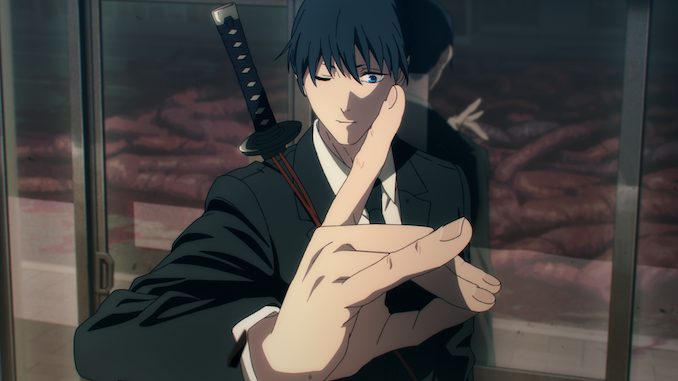Have You Seen Chainsaw Man? Anime’s Biggest Fall Premiere Lands Nimbly Amid the Hype
Photo Courtesy of Crunchyroll
There are many measures of success in the anime and manga industry. Chainsaw Man, the 12-volume manga by Tatsuki Fujimoto about a world where human fears corporealize as monstrous devils, recently surpassed 16 million copies in circulation in Japan alone, and it’s well on its way to competing with the towering commercial successes of its contemporary shonen series Demon Slayer: Kimetsu no Yaiba and Jujutsu Kaisen, both of which have set records around the world for what anime can do. But there are some metrics more revealing than sales figures alone, like cosplay.
Even a year ago, amidst the hype for new releases of Demon Slayer, Jujutsu Kaisen, One Piece, Dragon Ball, and Attack on Titan, anime cons were flooded with the white shirts and thin black ties of the Public Safety Division’s uniform. A government agency of Devil Hunters, who in Chainsaw Man fight back against the monstrous fears terrorizing civilians, the popularity of the altogether simple costume was conspicuous. At least in the U.S., the big names in anime have been just that – anime.
Usually, anime helps sell manga, which is the biggest incentive for manga publishers like Shueisha to sell the production and distribution rights of their properties. Anime is almost exclusively funded by production committees of various publishers, licensors, distributors, and merchandisers coming together to share in a risky investment. They may profit a little if an anime is successful, but they won’t lose much. The popularity of the Chainsaw Man manga, made possible by VIZ Media’s translation and digital distribution in English, managed to create a new avenue for success in an international industry. It’s no small feat that it has consistently appeared in New York Times Best Seller lists for the past year. But what, then, is there to make of this new anime?
There is money to be made, sure, but I think what Shueisha (the publisher), MAPPA (the animation studio), and Crunchyroll (the distributor) are playing for is something more important than record shattering profit—they want a cultural moment. Not a Demon Slayer with its international box office records, but a Dragon Ball with its iconography. Despite the commercial growth of anime in the past decade, hanafuda earrings and names like Yuji or Deku don’t carry any cultural staying power outside of anime fandom internationally. But everyone knows who Goku is (even if they think he looks like Vegeta). Here’s how they’re doing it.
In a fittingly unconventional approach to making an anime, MAPPA, the studio behind hit anime like Yuri!!! on Ice and Jujutsu Kaisen has foregone a production committee. It means they have much to gain, and much more to lose financially. But given everything about the series’ success, this doesn’t seem like a big gamble in the name of artistic vision. And MAPPA is a safe choice for a studio. Chainsaw Man even shares staff with crew on Jujutsu Kaisen 0, which first released in Japan less than a year ago and quickly became one of the best-selling anime films of all time.
I couldn’t tell you how drastically the anime adaptation would have differed from the one episode I’ve seen if Shueisha decided to go with a studio that wanted a production committee to take on the project. I’ve seen just the first of 12 episodes, which doesn’t give me much to go on other than: it’s faithful, so far. And so far what I like is that the anime is taking its time, knows when to ramps up or step back, and is unafraid to be somber and gray—all with an ambient post rock score by Kensuke Ushio (A Silent Voice) that kicks into overdrive alongside some of the best 3D animation I’ve seen anywhere.
While it covers some worldbuilding and exposition, the show—much like the manga—thoughtfully focuses on characterizing its protagonist, Denji, as an exploited young person. After inheriting his father’s debt to the yakuza, Denji very literally sells parts of his body to get by. He hunts nuisance devils for them to sell on the black market with the assistance of his pet, the canine Chainsaw Devil Pochita, and he lives in a literal shed, hungry. The commentary on the absurdity of debt, the precarity of contract work, and the very personal ways capitalism invades our dreams is all there.